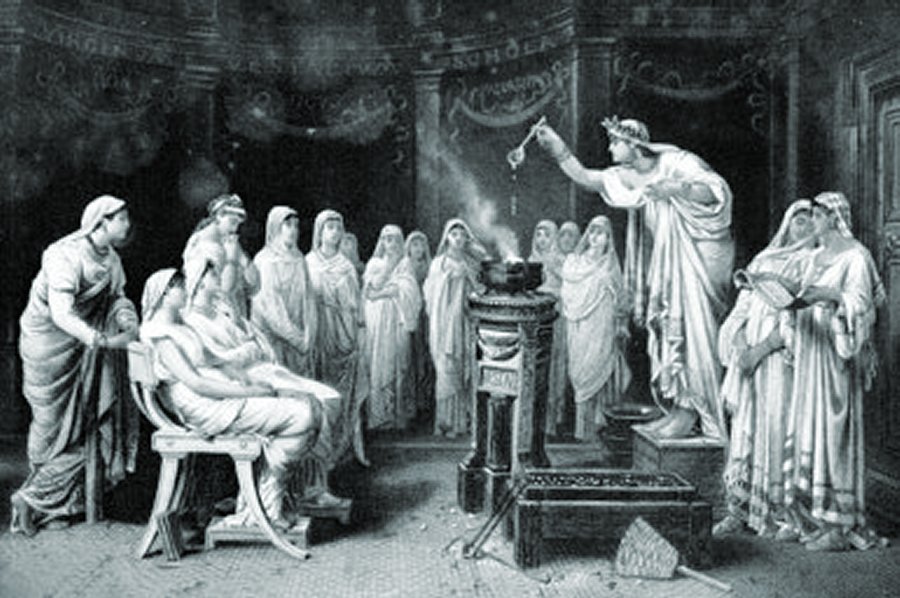Ancient Romans Loved White Teeth – All Means Were Acceptable To Get Them Even Portuguese Urine
A. Sutherland - AncientPages.com - The Romans loved their public baths but they also paid special attention to oral hygiene and had surprisingly healthy teeth.
Believed to be the strongest in the world and most effective, Portuguese urine was shipped in large quantities from Portugal for wealthy Roman ladies to use on their teeth, and the product was so popular that the Roman emperor Nero had to place a tax on it. Image via Bust
Aulus Cornelius Celsus (c. 25 BC – c. 50 AD) was a Roman encyclopaedist, historian of medicine and one of the most important contributors to medicine and scientific thought during the Roman Empire, was particularly well-known for his extant medical work, De Medicina.
Celsus stated that food leftovers in teeth can cause a disease called caries dentium, or simply caries.
“Even though fulsome white smiles were keenly prized in Roman high society, the rich were not about to forego their lavish dinners; they literally wanted to have their cake and eat it…” wrote Greg Jenner in his book “A Million Years in a Day: A Curious History of Daily Life”.
The ancient Romans knew about it and therefore, daily tooth brushing was their daily routine.
A Slave Helped A Roman Aristocrat With Tooth Brushing
However, a Roman aristocrat did not make his daily tooth brushing by himself. Instead he was helped by his own slave at home. In order to avoid the need for dentures, his slave would wield the soft twig, onto which polishing powders were applied, and then he would gently scrub his master’s teeth and gums to clean away food leftovers.
Traditional miswak sticks. (Photo: Middayexpress/WikiCommons CC BY-SA 3.0
In more serious cases, Celsus recommended filling the hole with lead (in Latin: lead means plombus), but the Romans did not like the treatment of cavities and it was the last option, particularly because of pain.
How Did The Oral Care Of The Average Roman Look Like?
"Refreshing" rinses were also used to promote oral hygiene. The composition of these substances, however, may seem somewhat unusual from our modern point of view. They also used several mixtures of ingredients similar to our modern kinds of toothpaste. However, sometimes, these mixtures – especially those proposed by Pliny the Elder – seemed creepy and disgusting. ¨
He advised to prepare good “toothpaste” that included “ashes head of hare and donkey teeth, mixed with extracts of mouse brain or hare”.
Celsus, Aulus Cornelius and De medicina libri VIII (daten.digitale-sammlungen.de
In fact, the use of the mouse brain was rather frequently used in ancient Rome. To get flavoring effect, it was mixed with bicarbonate sodium, powdered charcoal and bark. Other ingredients commonly used included a powder of ox hooves' ashes and burnt eggshells that was mixed with pumice.
The ancient Romans also had the habit to brush their teeth with … the urine. They made mixtures of goat milk and old urine to try to keep their teeth white.
Messalina, the wife of Emperor Claudius, for example, washed her teeth with a paste of powdered deer antler or “chose to gargle undiluted human urine, preferably the super-strength stuff shipped in all the way from Portugal where piss was believed to contain more ammonia…” G. Jenner writes.
The ancient Roman treatments of teeth were rather controversial at least but these were means they had if they wished to have white teeth. They efficiently removed the stone from their teeth but… they also removed the enamel, which certainly wasn’t easily restored.
Still, the Romans liked white teeth very much and neglected teeth were not welcome in Rome.
Written by – A. Sutherland AncientPages.com Staff Writer
Copyright © AncientPages.com All rights reserved. This material may not be published, broadcast, rewritten or redistributed in whole or part without the express written permission of AncientPages.com
Expand for referencesReferences:
Jenner G. A Million Years in a Day: A Curious History of Daily Life”
More From Ancient Pages
-
 Early Toilets Reveal Dysentery In Old Testament Jerusalem
Archaeology | May 26, 2023
Early Toilets Reveal Dysentery In Old Testament Jerusalem
Archaeology | May 26, 2023 -
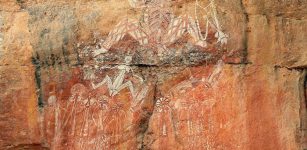 Machine-Learning Model Can Detect Hidden Aussie Rock Art
Archaeology | Jun 28, 2022
Machine-Learning Model Can Detect Hidden Aussie Rock Art
Archaeology | Jun 28, 2022 -
 Armenians’ Origin Theory By Herodotus Debunked By New DNA Study
DNA | Nov 27, 2024
Armenians’ Origin Theory By Herodotus Debunked By New DNA Study
DNA | Nov 27, 2024 -
 Long History Records Of Medicine In Mesopotamia And Sumer
Civilizations | Nov 20, 2017
Long History Records Of Medicine In Mesopotamia And Sumer
Civilizations | Nov 20, 2017 -
 Ancient Hindu High-Tech That Contributed To Modern Science
Civilizations | Nov 11, 2014
Ancient Hindu High-Tech That Contributed To Modern Science
Civilizations | Nov 11, 2014 -
 Baby God Hermes Started His Life As A Liar And Trickster
Featured Stories | Dec 25, 2020
Baby God Hermes Started His Life As A Liar And Trickster
Featured Stories | Dec 25, 2020 -
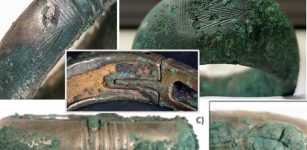 Intriguing Hoard Of Bronze Age Bracelets From Brittany, France Remains An Archaeological Puzzle
Featured Stories | Jan 30, 2024
Intriguing Hoard Of Bronze Age Bracelets From Brittany, France Remains An Archaeological Puzzle
Featured Stories | Jan 30, 2024 -
 Baku’s Mysterious Maiden Tower – Legend Of The Daughter Of Fire Who Saved The Sacred Temple May Be True
Featured Stories | Jul 5, 2021
Baku’s Mysterious Maiden Tower – Legend Of The Daughter Of Fire Who Saved The Sacred Temple May Be True
Featured Stories | Jul 5, 2021 -
 Looted ‘Pietas Domini’ Gothic Altar Dated To 1435 AD Returns From Germany To Poland
Archaeology | Mar 22, 2020
Looted ‘Pietas Domini’ Gothic Altar Dated To 1435 AD Returns From Germany To Poland
Archaeology | Mar 22, 2020 -
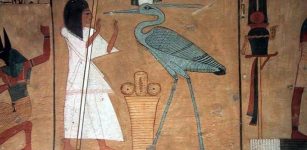 Mythical Egyptian Bennu Bird And Deity
Egyptian Mythology | Jun 5, 2016
Mythical Egyptian Bennu Bird And Deity
Egyptian Mythology | Jun 5, 2016 -
 On This Day In History: Battle Of Lissa Took Place In The Adriatic Sea – On July 20, 1866
News | Jul 20, 2016
On This Day In History: Battle Of Lissa Took Place In The Adriatic Sea – On July 20, 1866
News | Jul 20, 2016 -
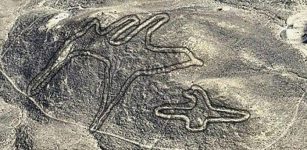 Nasca Lines: Researchers Identify 16 Bird Geoglyphs Drawn On Desert Plains Of Peru
Archaeology | Jun 23, 2019
Nasca Lines: Researchers Identify 16 Bird Geoglyphs Drawn On Desert Plains Of Peru
Archaeology | Jun 23, 2019 -
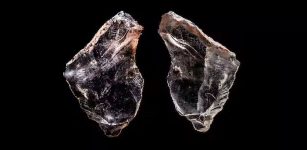 65,000-Year-Old ‘Stone Swiss Army Knives’ Show Early Humans Had Long-Distance Social Networks
Archaeology | Oct 22, 2022
65,000-Year-Old ‘Stone Swiss Army Knives’ Show Early Humans Had Long-Distance Social Networks
Archaeology | Oct 22, 2022 -
 5,000-Year-Old Arminghall Henge In Norwich Reveals Some Of Its Secrets
Archaeology | Dec 20, 2022
5,000-Year-Old Arminghall Henge In Norwich Reveals Some Of Its Secrets
Archaeology | Dec 20, 2022 -
 Major Discovery Reveals Neanderthals In Italy Engaged In Plant Food Processing
Evolution | Jun 29, 2023
Major Discovery Reveals Neanderthals In Italy Engaged In Plant Food Processing
Evolution | Jun 29, 2023 -
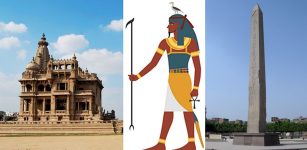 Geb – Egyptian God Of Earth And Member Of The Ennead – His Laughter Created Earthquakes
Egyptian Mythology | Feb 12, 2019
Geb – Egyptian God Of Earth And Member Of The Ennead – His Laughter Created Earthquakes
Egyptian Mythology | Feb 12, 2019 -
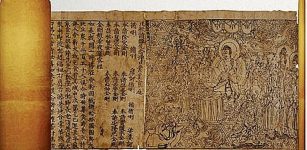 On This Day In History: ‘Diamond Sutra’ The Oldest Dated, Printed Book Is Published – On May 11, 868
News | May 11, 2016
On This Day In History: ‘Diamond Sutra’ The Oldest Dated, Printed Book Is Published – On May 11, 868
News | May 11, 2016 -
 Time Capsule – Best Preserved 3,000-Year-Old Dwelling Ever Found In Britain
Archaeology | Jan 12, 2016
Time Capsule – Best Preserved 3,000-Year-Old Dwelling Ever Found In Britain
Archaeology | Jan 12, 2016 -
 Infamous End Of Lugalzagesi – Ambitious King Who United Sumer
Featured Stories | Apr 30, 2020
Infamous End Of Lugalzagesi – Ambitious King Who United Sumer
Featured Stories | Apr 30, 2020 -
 Deir el-Bahri – Sacred Resting Place For The Pharaohs
Featured Stories | Mar 22, 2022
Deir el-Bahri – Sacred Resting Place For The Pharaohs
Featured Stories | Mar 22, 2022

